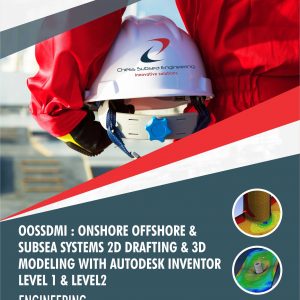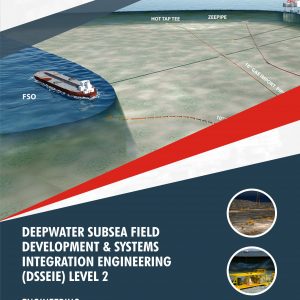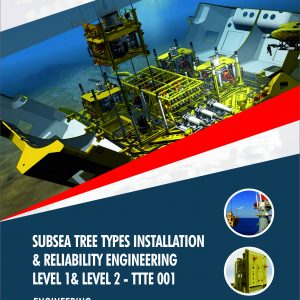Description
Subsea ROV (remotely operated vehicle) is an underwater vehicle that is controlled remotely by an operator on the surface. It is commonly used in offshore industries such as oil and gas exploration, marine research, and underwater construction.
Subsea ROVs are typically tethered to a surface support vessel, which provides power and communication to the ROV. The ROV is equipped with cameras, lights, and sensors that allow the operator to see and manipulate objects in the underwater environment.
ROVs come in a variety of sizes and designs, from small portable systems that can be operated by a single person, to large work-class ROVs that can lift heavy equipment and perform complex tasks. They can operate at depths of up to 6,000 meters or more, and are used in a wide range of applications, from inspecting pipelines and underwater structures to performing scientific research and exploring the deep sea.
Introduction to ROV Components, Intervention, Interface Requirement & Tooling Mechanism for Subsea Project Engineers & Entry Level Pilot Technicians (ROVIRTMSPEELPT) Level 1 covers overview of the state of the art for subsea remote intervention and vehicles, ROV technologies, and ROV capabilities and requirements for subsea operations, ROV Intervention Operations for Site Survey, Drilling Assistance, Installation Assistance, Operation Assistance, Inspection, Maintenance and Repair, ROV Intervention System, ROV Machine etc. ROV interface requirements based on API 17H, Remote-Operated Tool (ROT) and more.
Course Outlines
Subsea Production Systems
Subsea Field Architecture
Subsea Distribution Systems
Offshore & Subsea Surveys
Subsea Structures Installation and Vessels
Subsea Cost Estimation
Subsea Control Systems
Subsea Power Supply
Subsea Project Execution and Interfaces
Introduction to Remote Operation Vehicle & Intervention
Case Studies of ROVs & Specifications i.e. Mohawk, Super Phanton S2, Phantom 300 and Saab Seaeye eWROV
Factors Affecting ROV Operations
ROV Personnel Requirements & Responsibility
Training and Qualifications
Minimum Equipment needed for an ROV Mission
Integrated Navigation System (INS)
ROV Video Recording, Scientist Supplied Equipment & Shipment
ROV Project Mission Record Keeping and Documentation
Video Recording Procedures & Maintenance
Site Survey
Drilling Assistance
Installation Assistance
Operation Assistance
Inspection
Maintenance and Repair
ROV Intervention System
ROVs Categories
ROV Systems Topside Facilities
ROV Launch and Recovery Systems (LARS)
Umbilical and TMS
Characteristics of ROV Systems
Requirements for the typical interfaces based primarily on API 17H
Stabilization Tool
Handles
Torque Tool
Hydraulic Connection Tool
Linear Override Tool
Electrical and Hydraulic Jumper Handling Tool
ROT Configuration
Pull-In and Connection Tool
Component Change-Out Tool
Introduction to Piloting Underwater ROV
A Case Study of Panther XT Plus ROV
ROV Pilots Operating Environment
ROV Optimization
ROV Crew
ROV Buoyancy and Stability
Introduction to Operational Procedures
Communications
Deployment and Recovery
Pre and Post Dive Check List
Post Dive Procedures
Emergency Operations
Tether in Vessel’s Propeller (s)
Tether Severed Completely
Hours of Operation
Operation Modes
Live Boat Operations
Night Operations
ROV Maintenance
Appendix 1: Downloadable Sample of ROV Dive Log for Supervisors
Appendix 2: Downloadable Sample of Minimum ROV Components Checklist for Supervisors
Appendix 3: Downloadable Sample of ROV Pre Dive Checklist for Supervisors
Appendix 4: Downloadable Sample of ROV Post-Dive Checklist for Supervisors
Appendix 5: Downloadable Sample of ROV Trouble Report Form for Supervisors
Appendix 6: Downloadable Sample ROV Piece Weight List Form for Supervisors
Appendix 7: Downloadable Sample ROV Mission Coordination Daily Log for Supervisors
Appendix 8: Downloadable Sample of ROV DIVE Summary for Supervisors
Appendix 9: ROV Tether Management for Supervisors
Technical Support References
Ref 1: Overview of ROV systems and their applications in subsea operations
Ref 2: Types and classifications of ROVs
Ref 3: ROV components and their functions
Ref 4: Introduction to ROV control systems and communication interfaces
Ref 5: ROV intervention methods for subsea operations
Ref 6: Manipulator arms and tooling systems used in ROV interventions
Ref 7: Understanding ROV sensors and imaging systems for visual inspections and data collection
Ref 8: ROV navigation and positioning techniques
Ref 9: Subsea infrastructure and equipment interfaces for ROV operations
Ref 10: Interface standards and guidelines for ROV integration
Ref 11: Umbilical management and tethering systems
Ref 12: Power and data transmission requirements for ROV operations
Ref 13: Overview of ROV tooling mechanisms used for subsea tasks
Ref 14: ROV-mounted cutting, gripping, and sampling tools
Ref 15: Tooling interfaces and compatibility considerations
Ref 16: Safety protocols and procedures for ROV operations
Ref 17: Risk assessment and hazard identification in subsea environments
Ref 18: Maintenance and inspection practices for ROV systems
Ref 19: Case studies and lessons learned from real-world subsea projects
Ref 20: Overview of relevant industry standards and regulations governing ROV operations
Ref 21: Compliance requirements and documentation for subsea projects
Ref 22: ROV operations environmental considerations and mitigation measures
Ref 23: Exploration of emerging technologies in ROV systems
Ref 24: Trends in autonomous and unmanned subsea operations
Ref 25: Discussion on the future of ROV systems and their impact on subsea projects
Ref 26: Piloting Underwater ROV
Ref 27: ROV Operational Procedures
Ref 28: ROV Operations JSA
Ref 29: ROV Mobilization Procedures with JSA
Ref 30: ROV Demobilization Procedures with JSA
Ref 31: A case study of ROV Mobilization & Demobilization
Assessment
Participant underpinning knowledge of ROV Intervention, Interface Requirement & Tooling Mechanism will be accessed with short answer multiple-choice questionnaire at the conclusion of the course.
Outcome
Participants will gain an in debt understanding of ROV Intervention, Interface Requirement & Tooling Mechanism .They will also be able to function with minimum supervision as Offshore Engineers, Technicians & Subsea Engineers, Subsea ROV Technician, Subsea Project Engineer for IOCs, Offshore Drilling & Installation Contractors.
Professional Certificate
Issued directly by Chess Subsea Engineering Europe.
Participant may be presented for Offshore Petroleum Training Organization (OPITO) Certification.
How to Register
Click here to download registeration booklet on msword and email completed booklet to info@chesssubseaengineering.org directly.










